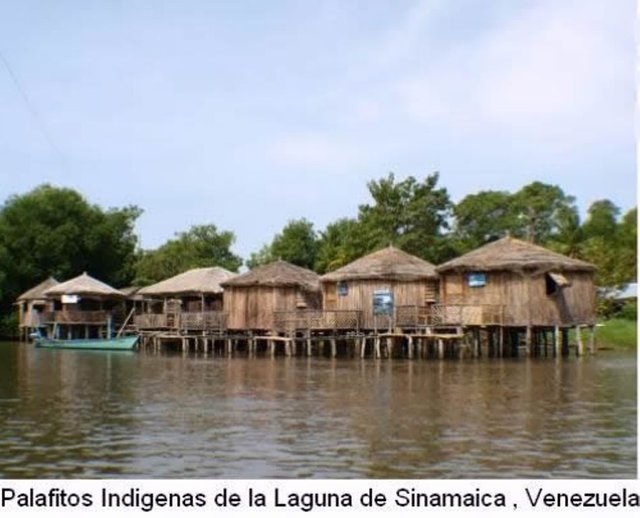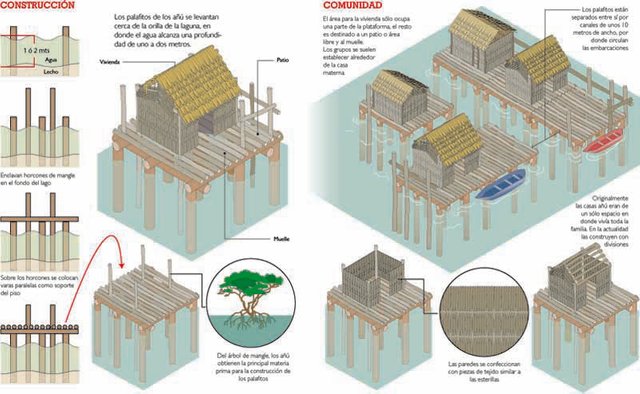PALAFITOS ON THE LAKE OF MARACAIBO
ECOLOGICAL HOUSES
The palafítos offer good conditions of conservation for, among other things, the wood and the rests of weaves and plants.
The reason why this type of construction rises is usually to protect oneself from the flooding of the water in marshy lands or rivers. The stilt houses are usually constructions typical of societies with precarious economies, generally linked to fishing. Although nowadays, these types of construction typologies are being used to adapt them to tourist uses in many regions.

Towns on the water in Maracaibo Lake
At present, there are still towns that have remained in the waters of Lake Maracaibo, such is the case of the Santa Rosa stilt houses located north of the city. In this place it is common to find children of indigenous traits bathing in the waters and canoes that come and go. The stilt houses of Santa Rosa have kept in their structure that memory of our ancestors, becoming today a tourist hostel where you can taste and enjoy the richest delicacies in an exotic place outdoors and on the waters.
Another town can be found in the Sinamaica lagoon. Located in the north of Zulia State, this lagoon is really a fantasy: here not only tourist resorts are found, but also dozens of families, stores, pharmacies and any store of commerce within the waters.
Its particular communication from one place to another through canoes and boats, its majestic town that seems planted in the waters, its culture, its customs and its idiosyncrasy have made the Laguna de Sinamaica one of the most important tourist and recreational sites from the Zulia region.

Indigenous palafitos of the Sinamaica lagoon
CONSTRUCTION OF PALAFITOS
By anthropological studies are located the first fixed dwellings in the Meso-Indian period, which covers the period between 5,000 and 1,000 BC.
This is possible to affirm, because in that period there is a change in the living conditions of those who lived in the Continent, as a consequence of the climate and vegetation modifications that conditioned the disappearance of the large mammals, which allowed them to to these ancient settlers, become collectors and fishermen, as attested by the remains found on the coasts and islands of the region.
The first architects specialized in this type of construction, were the natives called añú or paraujanos. Thousands of years ago they inhabited the northwest of the Venezuelan coasts, and the lacustrine areas of that subregion. That culture is recognized as the original builders of the palafittes.
The initial idea to build their homes is associated with the trees of the coastal forests of those places where the main settlements were made, specifically the so-called mangroves, being the Red Mangrove tree (Rhizophora mangle), with its wading roots which served as the first foundations of those old houses, later they were built on columns of those same trees but independently.
In the present the ecological houses are defined as those that achieve optimal habitability conditions with minimum energy consumption, taking into account the orientation of the construction, the land and the nature that surrounds it.
They must be self-sufficient and self-regulated, with maintenance that does not depend on non-local sources of energy. Capable of reusing rainwater. Built with non-toxic materials. Must have zero emissions, landscape integration, in harmony with the living environment.
Those ecological houses the Añu millenarian already inhabited them.

SOURCE:
You are blacklisted by this bot for not using your own photo:
https://busy.org/@thepajaro/golden-hour-photography-photocontests
Please contact @juliank(juliank#1775) on Discord in case of a false flag
World of Photography
>Visit the website<
You have earned 5.05 XP for sharing your photo!
Daily photos: 1/2
Daily comments: 0/5
Multiplier: 1.01
Server time: 04:53:37
Total XP: 84.15/100.00
Total Photos: 15
Total comments: 6
Total contest wins: 0
Follow: @photocontests
Join the Discord channel: click!
Play and win SBD: @fairlotto
Daily Steem Statistics: @dailysteemreport
Learn how to program Steem-Python applications: @steempytutorials
Developed and sponsored by: @juliank